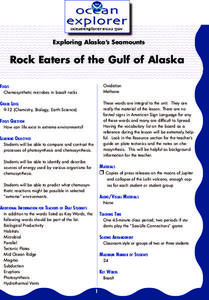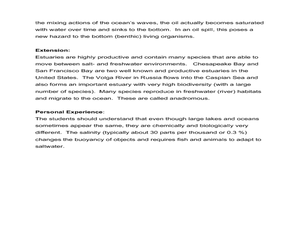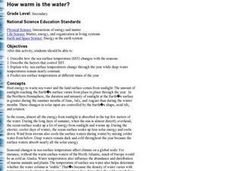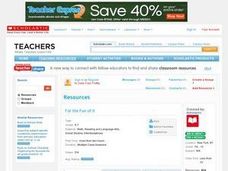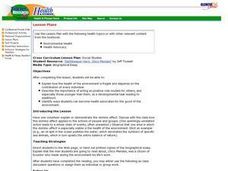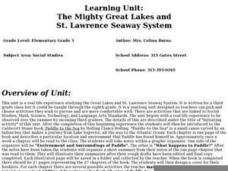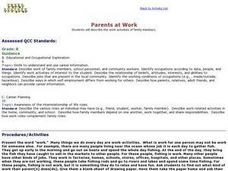Curated OER
Something Fishy
Students identify and discuss the adaptive characteristics and behaviors of fish. They view slides of fish, and design and create a model of a fish of the future, listing the ways their fish adapt to survive.
Curated OER
Where's the Beach?
Students use beach profile data to analyze how erosion and sediment transport changed seashore slopes. In this geology activity, students plot the data provided and analyze erosion patterns. They also assess coastal erosion management...
Curated OER
Head to Foot
Students describe the body form and major anatomical structures of squids and describe some unusual or unique features of newly-discovered deep water squid species. They infer what types of food squids use from their anatomical features.
Curated OER
Rock Eaters of the Gulf of Alaska
Learners compare and contrast the processes of photosynthesis and chemosynthesis. They identify and describe sources of energy used by various organisms for chemosynthesis.
Curated OER
Salmon Smolt: Stella PC and Mac
Students investigate the Stella Smolts Migration Model and its use in previous simulation models to help managers deal with the many factors contributing smolts decline. They participate in an interactive exercise in the role of fishery...
Curated OER
Teacher's Guide For: Water Temperature and Salinity Experiment
Students experiment with water density, temperature and salinity. In this water instructional activity, students observe how the coldest water sinks to the bottom of a test tube, and how saltwater sinks in comparison to freshwater.
Curated OER
How Warm is the Water?
Students research how surface sea temperature changes throughout the year. They draw a time series of sea surface temperatures for each month of the year and a depth profile for a summer and winter month using an OceanExplorer Profiler...
Curated OER
Search for the Humpback Whale
Students work in teams to research and explore whale adaptations, behavior, migration, habitat, communication, and interactions with humans and present their findings.
Curated OER
Trade (Hawai'i)
Students gain further understanding of the diversities of trade and the cultural impact of the trade items. Students evaluate and analyze trade items and use this knowledge to make sound trade decisions. Students describe and analyze the...
Curated OER
Learning About Bears And Dolphins
Seventh graders engage in a study that compares the body structures of bears and dolphins. They conduct research to find information and use questions to find the differences or similarities and then conduct a class discussion about the...
Curated OER
Learning About Mammals
Young scholars study the mammal classification and forms of them living in the United States. In this mammal study lesson, students read through orders of mammals that exist in the United States. Young scholars also study the taxonomy of...
Curated OER
There Are Algae in Your House!
Learners demonstrate that, although we sometimes can neither smell nor taste them, many ingredients in our foods and household products come from the sea. They also investigate food eat to determine algae derivatives they contain.
Curated OER
A Day at the Beach
Student read Sheryl Wilson's story, "A Day at the Beach" while classifying items they find. They design a chart of the items before using educational graphing software to create a graph.
Curated OER
Fighting Conservation Crime
Young scholars identify and interpret the evolution and sources of law in Canada. Students compare and contrast the legal rights and responsibilities of individuals, groups, and organizations in Canadian society. Young scholars write a...
Curated OER
Introduction to Ecology
Eighth graders identify the living and nonliving components of an ecosystem. In this ecology lesson, 8th graders explain the role each organism plays. They participate in class discussion and answer a quiz at the end of the lesson.
Curated OER
Where is That Light Coming From?
Students investigate the chemistry of bioluminescence and discuss how various organisms benefit from this trait. They prepare a report about of at least one organism that receives each of the benefits discussed.
Curated OER
For the Fun of It
Middle schoolers investigate author's purpose in autobiography by reading Amelia Earhart's autobiography entitled The Fun of It. Learners examine character traits needed to fulfill personal goals.
Curated OER
Lewis and Clark In Columbia River Country Native Foods
Pupils complete an online activity by following a series of prompts to determine seasonal foods that could be found in the Columbia basin during the Lewis and Clark expedition. They draw a seasonal round that shows a colorful...
Curated OER
The Dot and Dashy Language
Students examine and discuss the Morse Code. In small groups they develop messages using Morse code and take turns decipering the messages.
Curated OER
Biographical Essay
Tenth graders explore the importance of the environment and ow fragile it is.
Curated OER
The Mighty Great Lakes and St. Lawrence Seaway System
Students participate in a variety of activities in a unit about the Great Lakes/St. Lawrence Seaway System. They create a diorama, read related stories, and correspond with other classes located in other port cities along the St Lawrence...
Curated OER
Water Quality
Students investigate the water cycle and evaporation. They study the porosity and permeability of groundwater, and the capillary action in soil in this unit.
Curated OER
Swim Like a Whale or Fish?
Students recognize the difference between whales and fish by categorizing them according to their method of swimming. They synthesize this information by simulating the swimming patterns of whales and fish and comparing it to their own.





